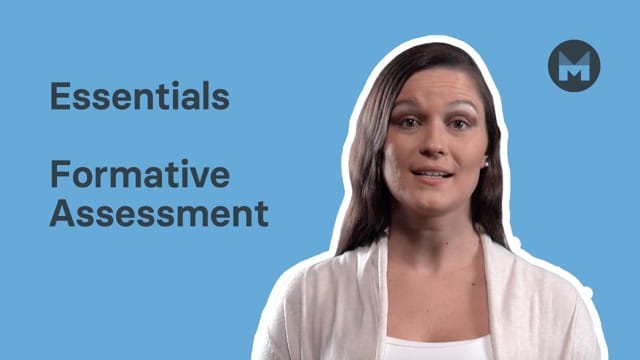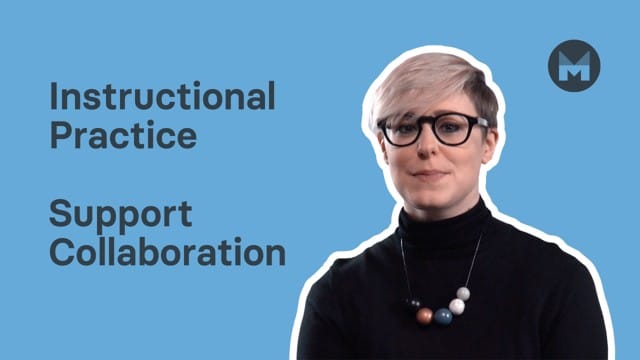How to align assessment with student learning outcomes
In this guide
Understanding the importance of assessment alignment
Aligning assessments to student learning outcomes is vital when creating a system where lessons, learning, and assessments are interconnected. Often the process of aligning assessment with student learning outcomes is called backwards design or backwards planning.
Determining how students will be assessed and what they will be assessed on before developing lessons, helps focus on the goals and the learning itself. Learning should not be arbitrary. Alignment gives learning purpose, focus and timing to units of work.
There are four major benefits of aligning assessments to student outcomes.
1) Helps build better lessons
Alignment makes for better lessons. When teachers plan with the end in mind, the lessons focus on the skills needed to show mastery.
Creating lessons with the end in mind means that the teacher knows what will be assessed and is able to drive instruction in a way that encourages better students outcomes.
2) Learner focused
Assessment alignment is learner focused. The focus is on instruction that guides the students to master skills.
Learner focused teaching includes scaffolds where appropriate and the use of formative assessments to adjust instruction when needed.
3) Continuous improvement
The use of assessments that are outcome-based allows for continuous improvement for both students and teachers.
Students are given frequent feedback and focused instruction. Teachers are able to assess student needs and adjust instruction accordingly.
4) Better assessments
When assessments are aligned to student outcomes they become more authentic. We should assess what we teach. It is unfair and unproductive to give an assessment which covers content that students have not learned or are yet to learn.
Best practices for designing outcome-based assessments
When designing outcome-based assessments there are a few best practices to keep in mind. These practices ensure that assessments are meaningful and related to the content.
1) Formative assessments
Formative assessments are any assessment the teacher uses to shape instruction. They are not always formal assessments, but they can be informal assessments like observations. They are anything the teacher uses to drive their instructional practice and student outcomes.
Embedding formative assessments into lessons allows a teacher to have a better idea of what further support and instruction students need to understand the information.
Types of formative assessments include strategic questioning, quizzes, think-pair-share exercises, student polls, and more.
2) Clear learning objectives
Learning goals or objectives are an excellent way to connect learning to student outcomes. The goal of the lesson should be clear to the students and the instructor.
Clear learning objectives that are aligned to student learning goals, allow the teacher to focus the lesson. They allow the teacher to know what needs to be taught and what the students are expected to be able to do.
Learning objectives are also important for students. When students have a clear understanding of what the purpose of their learning is, they can focus their attention. Knowing what the end result will be, changes the way students interact with content.
Learning objectives are important no matter the subject matter. Learning objectives should consist of two parts: what the students will learn and how they are going to demonstrate their learning.
Examples of clear learning objectives:
- I will learn how to identify the main idea in a narrative text, so I can write a 3 sentence summary of the story.
- I will learn to multiply two-digit numbers by two-digit numbers, so I can solve word problems using multiplication.
- I will learn how energy flows within an ecosystem, so I can create an accurately labelled food web diagram.
- I will learn how authors develop themes in a fictional text, so I can use textual evidence to support a theme during a class discussion.
- I will learn about the causes of World War II, so I can use evidence to summarise three key causes in a written paragraph.
Each of these learning objectives contains a clear learning goal and assessment goal. Students will know what they are going to learn and how they must apply their learning.
3) Authentic assessments
In order for assessments to align with student learning outcomes, they must be assessments that measure mastery of concepts and skills. We cannot expect to accurately measure a student’s growth and skills if the assessment does not reflect the skills the student was given an opportunity to learn!
So, how do we create authentic assessments? It is also important that assessments present clear and concise expectations. Students need to know what they are being assessed on and be given the opportunities to internalise that information.
The criteria for assessment should also be clear and consistent. Clear assessment criteria is important so that students are more likely to take responsibility for their learning. Consistent criteria influences assessment validity. If there are different expectations for what mastery looks like, then structuring lessons that are aligned with student outcomes will be almost impossible.

4) Rubrics
Rubrics are a useful tool for connecting learning and outcomes. A rubric informs a student how they will be evaluated. Rubrics can be created for just about any type of assignment – essay writing, oral presentations, visual presentations, artwork, and more.
There are different types of rubrics that can serve different purposes, but the focus should be on how their work will be evaluated. It is beneficial for students to know what knowledge and skills they will need to demonstrate.
As an added bonus, rubrics are also a useful marking tool. They can decrease the amount of time it takes to mark extended or involved projects and presentations. They are great for marking essays as well.
5) Frequent feedback
A significant part of designing aligned assessments is including frequent feedback. Students who receive frequent feedback know what it is they need to work on in order to achieve; this helps them to grow as learners.
Frequent feedback is also important for teachers. Frequent feedback allows a teacher to quickly correct misconceptions. Through giving feedback, teachers also know when students need reteaching or extension activities. Information for feedback can come from observations, class discussions, formative assessments, and summative assessments.
Feedback can come in many forms depending on the situation. Verbal and written feedback are the ones with which we are most familiar. However, I know of a teacher who gives verbal feedback through voice notes for digital assignments.
Feedback should be timely and specific to be most effective. Giving feedback while the assignment or task is fresh in students’ minds makes it more impactful as this allows students to be able to make adjustments and expand their learning.
Specificity is also important to effective feedback. Being specific provides students with a better understanding of their strengths and areas where growth is needed.
Strategies for aligning teaching, learning, and assessment
1) Align assessments to learning objectives
As we have already discussed, it is important to have clear learning objectives. The goals should be aligned with all assessments – formative and summative.
The easiest way to align learning objectives with assessments is to start with the assessments. Knowing what is going to be assessed can guide the development of what is taught. Different types of assessments require different types of instruction.
This does not mean that you are doing what is called “teaching to the test”. The purpose is to know what is being assessed so that those skills are incorporated into the lessons provided to students.
2) Review learning objectives often
Humans are forgetful beings. We often need reminding. Reviewing learning objectives keeps them fresh in our minds. This allows the class to refocus their attention and efforts.
Reviewing goals allows the teacher and students to reflect on the learning they have done and to determine if they are on course to achieve the objectives. If the class is on course to meet their goals, they can continue moving forward. However, if they have veered from the path, they can course correct.
3) Formative assessments
Formative assessments help teachers to align what students are learning with their teaching. Using formative assessments helps a teacher to know what students are learning and if their teaching is being effective.
Formative assessments should happen often. A teacher can adjust their teaching according to these assessments. This gives the teacher data to support student learning and progress.
4) Varied assessment types
Using different types of assessments is essential for alignment. Not every student responds to assessments the same way. There are multiple ways to assess just about any subject matter.
Administering different assessment types gives the teacher a broader understanding of student skill mastery. Presenting information in different ways increases the likelihood that students will learn the information. Students simply do not all learn at the same rate and in the same way.

5) Scaffolding
Use scaffolding strategies to support students that need those extra supports. Scaffolding strategies vary according to student needs, but they include sentence stems, mentor texts, writing checklists, and graphic organisers.
Scaffolding strategies can be used for any students that need them. Often language learners and students with special needs may need them, however, any student that is struggling to master skills and concepts.
Using formative and summative assessments effectively
Using assessment data effectively means that the data is being used to guide instruction and to make decisions regarding student learning needs. Formative and summative assessment data is used differently, but it is important that the data is used to inform teacher’s planning decisions.
Formative assessments
Formative assessments are used to adjust instruction in the moment or soon after. By using a formative assessment, a teacher can see the progress students are making in real time. This is beneficial for every student. A teacher can identify and correct misconceptions, support students that are above level, and assess if the way they are teaching is supporting student learning.
After conducting a formative assessment, the teacher must review student responses and determine student needs. Sometimes, a formative assessment may reveal that students are mastering the skills and concepts and the teacher can continue teaching. However, more often a formative assessment will show students that need additional support and the teacher can provide those supports.
Examples of formative assessments:
- Think-pair-share.
- Exit tickets.
- 1 minute papers.
- Short quizzes.
- Classroom discussions.
- Peer editing.
- Diagnostic assessments.
Summative assessments
Summative assessments are given at the end of a learning period. This can be at the end of a unit, a term period, or the end of a course or program. Ideally, a summative assessment evaluates student learning throughout the entire period of learning. Summative assessments should include skills that students should have mastered over the course of the learning.
Examples of summative assessments:
- Final exam.
- Presentations.
- Unit quizzes.
- Portfolios.
- Projects.
- Reports.
Tools and techniques for measuring student learning outcomes
Measuring student learning outcomes can happen in various ways. Ideally, student learning outcomes should be measured in multiple ways so that the teacher has a well rounded idea of student learning and mastery.
Ways to measure student learning outcomes:
1) Portfolios
Portfolios are an excellent way to see student growth over time. Portfolios can be kept physically or digitally. They are also great to pull out for parent-teacher conferences! They are also a useful resource for goal setting with students.
Previously, I worked where student writing portfolios were widely used across all year levels. These included samples from each year which were kept digitally in our student management system. Teachers could access them each year as the students were rostered into their classes. The information was useful and helped teachers identify student needs.
2) Surveys
Surveys are a great tool for reflection. They can be used to measure students’ understanding of their learning. Surveys allow students to express what worked for them as learners, and what did not work.
A survey can be used to evaluate the effectiveness of our teaching as well. Teachers can reflect on survey data and refine teaching practices. These are very easy to make digital as well. Creating a survey is a constructive use of AI that can save a teacher time. Saving time is always a great thing in education!
3) Rubrics
I have already discussed the use of rubrics, but they are a great tool for measuring student learning outcomes. Specifically, developmental rubrics are a useful tool. Like a portfolio, a developmental rubric assesses a student’s development of a skill or skills over time.
Rubrics are useful for marking student work. They let the students know the expectations and how an assignment will be graded. I like to give my students the rubric when I introduce a topic or project. Then students are prepared for the work and know how they will be evaluated.
4) Project-based learning
Project-based learning is a student-centred approach to learning. Students participate in active learning through real-world projects and situations. They learn skills that can be applied beyond the classroom alongside the curriculum itself.
Often project-based learning is cooperative and students work together to complete tasks. This aids in the development of communication and collaboration skills. Project-based learning also helps students to learn about time management skills because they must complete tasks by specific deadlines.

5) Performance tasks
Performance tasks are a way for students to demonstrate their skills by performing a specific task. Unlike project-based learning, performance tasks are usually not cooperative in nature.
Examples of performance tasks:
- Design and conduct a scientific experiment.
- Perform a piece of music.
- Create an interactive timeline.
- Create a piece of artwork.
- Conduct a debate.
- Create and give a presentation.
- Problem solving activities.
Aligning assessment with student learning outcomes creates a better teaching and learning environment. Learning objectives, formative assessments, and summative assessments work together to create alignment that benefits both teachers and students.
Sources:
- Cain, S. and Laird, M. (2011) The Fundamental Five: The Formula for Quality Instruction. CreateSpace Independent Publishing Platform.
- Duckor, B. and Holmberg, C. (2017) Mastering Formative Assessment Moves: 7 High-Leverage Practices to Advance Student Learning. Alexandria, V.A.: ASCD.
- Utaberta, N. and Hassanpour, B. (2012) ‘Aligning Assessment with Learning Outcomes’, Procedia Social and Behavioral Sciences, 60, pp. 228-235. Available at (https://www.sciencedirect.com/).

Mattie Farrer
briefcase iconAVID Site Coordinator / Content Curator
Mattie Farrer has been an educator in various grade levels and capacities during her career. She has a passion for supporting English learners and their language development. She also loves helping teachers reach all students.
Other posts
Want more content like this?
Subscribe for blog updates, monthly video releases, trending topics, and exclusive content delivered straight to your inbox.












